Ringo Starr and Barbara Bach are decluttering and downsizing, from Monaco/Surrey/Snowmass/Beverly Hills to LA and a London apartment. Nearly 1400 lots of furniture, art, clothing, memorabilia, and borderline boot sale junk will be auctioned this week in LA. Here are some of the things:
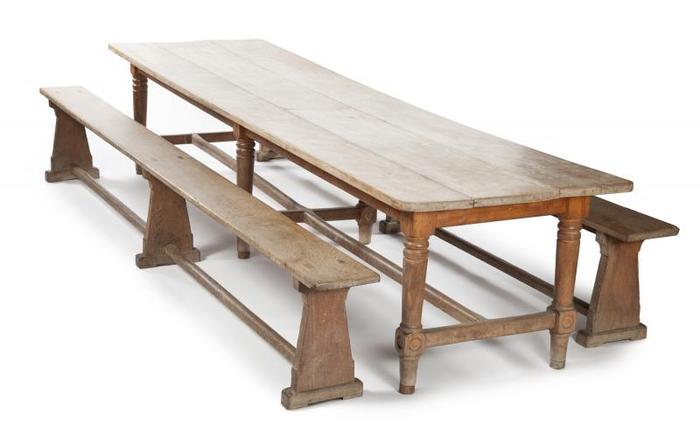
First up, Lot 79, Originally John Lennon and Yoko Ono’s Refectory Table [est. $5-7,000, sold for $19,200]
“‘This refectory table was left at Tittenhurst by John and Yoko when I took over the house. Enjoy!’ – Ringo.” That would be in 1971. Tittenhurst Park was outside London. Starr sold it to the Emir of Abu Dhabi in 1988, but took the table with him. Hey, here it is in the living room of Rydinghurst, Starr & Bach’s Jacobean estate in Surrey, which they put up for sale last year. Look at how they lay down a Google-like blur on the artwork in estate agent photos.

And speaking of tables, what is up with that coffee table? It’s big and moon-shaped and filled with gazing balls. Or giant Christmas ornaments? I cannot tell, and the designer Ringo Starr doesn’t weigh in this time.
Lot 351, Moon Coffee Table Designed by Ringo Starr [est. $1,000-2,000 sold for just $1,920]
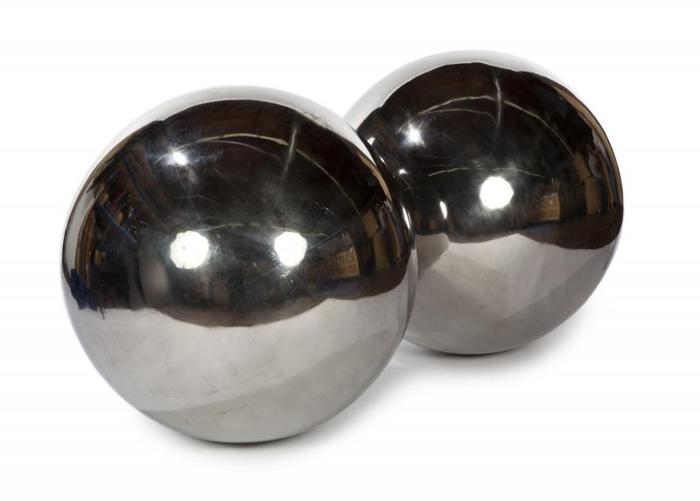
And speaking of gazing balls, holy smokes. Lot 608, Two Monumental Gazing Spheres [est. $3,000-5,000] They’re from Rydinghurst, and each one is 36 inches across. Let’s see Jeff Koons try to handle those. [WHAT, sold for just $1,920? Why didn’t you ever get back to me with the condition report??]
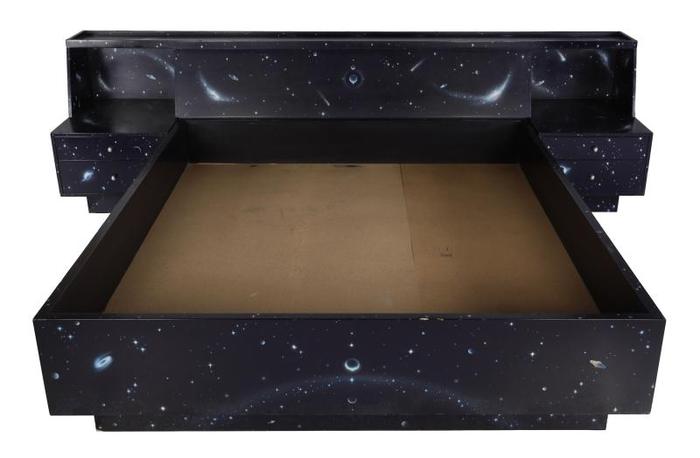
And finally, speaking of satelloon-looking things, Lot 411, Galaxy Theme Platform Bed [est. $800-1,200] “‘When we bought the house in 1992 in LA, we had this bed made so we could sleep under the stars and moons, and surrounded by the stars and moons.’ – Ringo.” Will the presumably LA-based Master Of The Ringo Starr’s Bed Starscape with the initials SWG please come forward and take a bow? [Yes, well, sleeping in Ringo and Barbara’s bed? Priceless, but apparently they’ll take $875.]
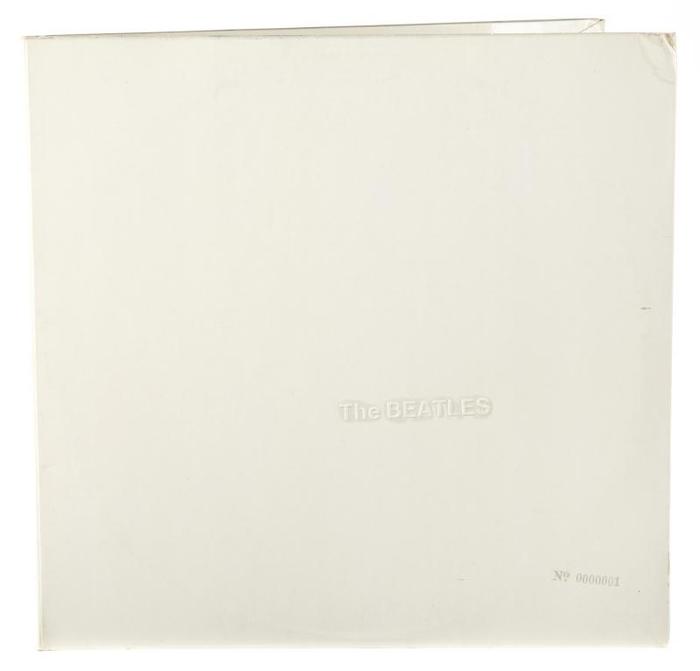
Lot 1005, **RINGO STARR’S UK 1st MONO PRESSING WHITE ALBUM NO.0000001 [est. $40-60,000]
Oh wait, no, one more: It turns out Ringo got the first numbered copy of the White Album, and he put it in a vault. Now it is selling for at least $55,000. What a world. #monochrome [WHAT A WORLD INDEED: $790,000.]
Property from the Collection of Ringo Starr & Barbara Bach, 12/03/2015 [julienslive via jjdaddy-o]
Category: satelloons
On The Golden Record
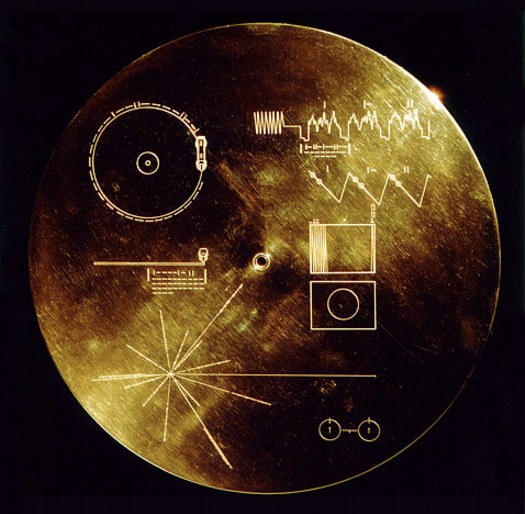
Could this really be happening? Four years ago I wished for a way to play back the Golden Record, the earthly calling card stuck to the sides of the Voyager space probes nearly 40 years ago. I knew all the recordings and diagrams and photos Carl Sagan and friends recorded on there, but I wondered what it would actually be like to play it back? What would the 116 images turn out like if you played them off an analog record with a needle, and then assembled the 512 raster lines?
I wanted to find an extra Golden Record and play it, which turned out to be hard-to-impossible. And also unnecessary. [Though I’m still game, if you have a Golden Record I can borrow!] Because the Record has been played.
A few weeks ago, Man Bartlett tweeted about some strange electronic passages in a NASA recording of the Golden Record:
@ranjit @ManBartlett @NASAVoyager here’s the IA version https://archive.org/details/Voyager1
— gregorg (@gregorg) August 6, 2015
And then sound artist Ranjit Bhatnagar identified them as the encoded data for the 116 photographs. Here’s one of the first images Ranjit processed, the aliens’ intro to Earth Math:
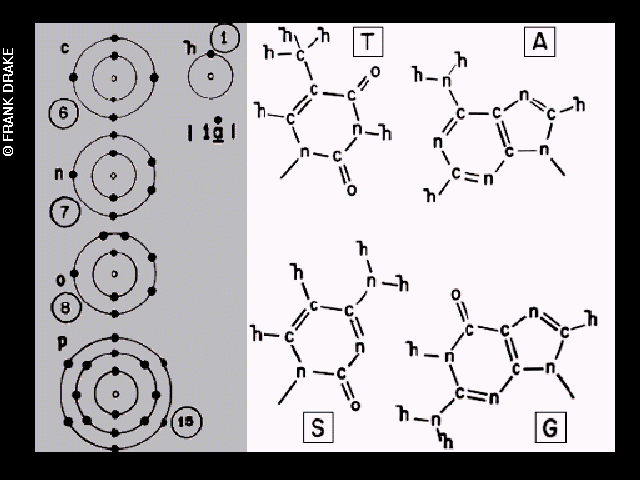
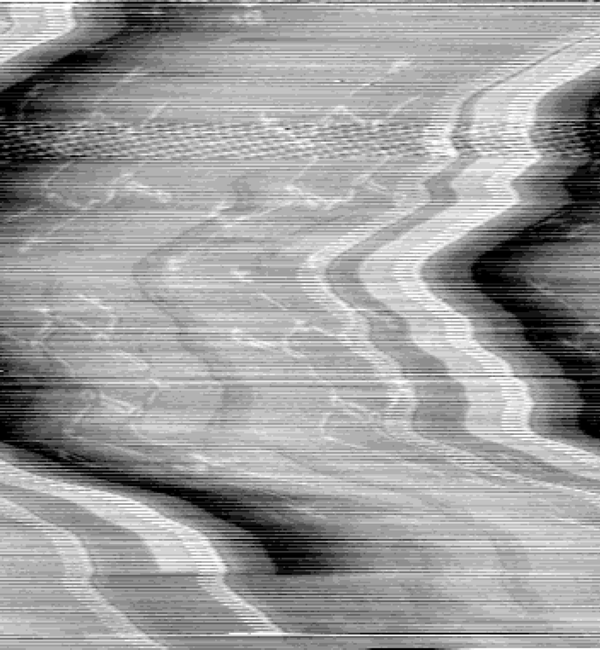
above: Image of math chemistry from Voyager 1 by Frank Drake, below: same image decoded by Ranjit Bhatnagar
@ManBartlett @NASAVoyager @gregorg here’s the intro to math page (and the original) pic.twitter.com/ATQYMpoZLz
— Ranjit Bhatnagar (@ranjit) August 6, 2015
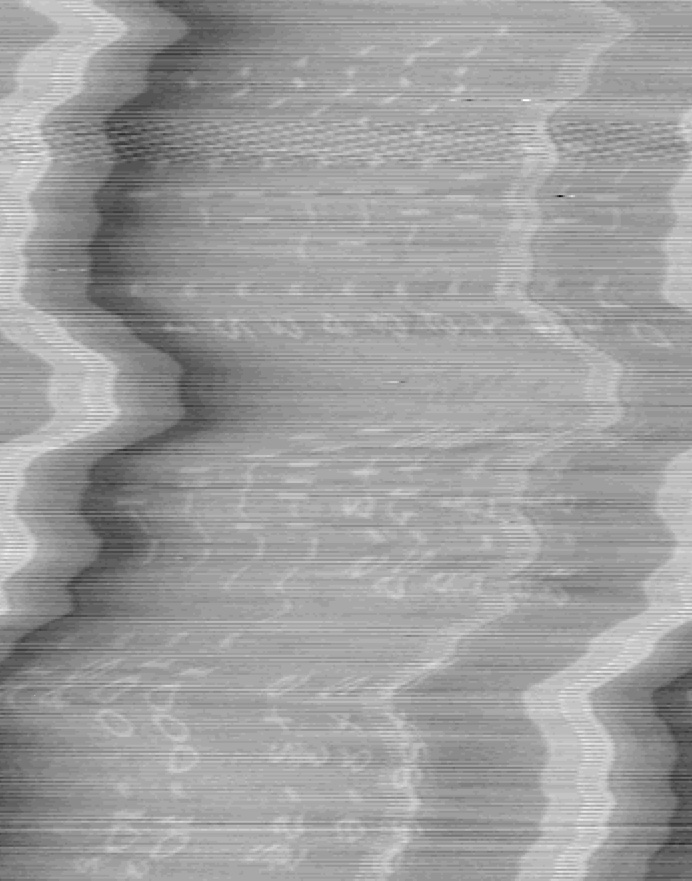 [images from ranjit’s tweet, decoded math above, and original below]
[images from ranjit’s tweet, decoded math above, and original below]
So this is it. The answer was sitting right there on the Internet Archive the whole time. And yet.
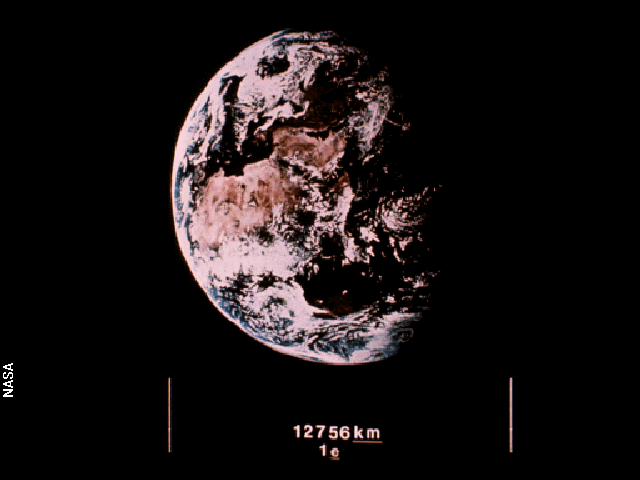
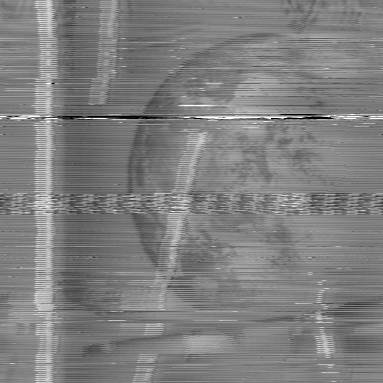
above/below: image of Earth, and image of Earth decoded from Voyager 1 by Kyle McDonald
Within a few minutes of Ranjit’s decoding, code artist Kyle McDonald happened by, and blew things wide open with his distortion adjustments, which he promptly documented and pushed to github. So it just took four years and one serendipitous hour. And now we know that the images we’ve sent out into the universe look like a 1970s TV with a tinfoil antenna.
Voyager1 audio track [archive.org]
Kyle McDonald | Voyager 1 Decoding [github]
Previously: Off The Golden Record
The Berkowski Daguerrotype

The first successful photographic image of the sun’s corona was taken 164 years ago today. A daguerrotypist named J. Berkowski was brought to the Royal Observatory in Königsberg, Germany (now Kaliningrad, Russia) by the director, Augustus Busch, to record a solar eclipse on 28 July 1851. According to this 2005 paper in Acta Historica Astronomiae, Berkowski soon made some daguerrotype reproductions. Busch commissioned Robert Trossin of the Royal Academy of Painting to make a steel engraving of the daguerrotype. In 1891, CFW Peters had Berkowski’s original daguerrotype photographed for publication. It has since been lost.
Four of Berkowski’s copies were known, including one in the Jena Friedrich Schiller University in Jena, Germany [above]. The order of copying events in the Jena description does not quite line up with the 2005 paper, even though the author, Dr. Reinhard Schielecke, is the same.
The moon in the 2nd-generation daguerrotype is tiny: 8.7mm across. The original was under 8mm. The Jena print is thus only around 5x6cm, as wide as the screen on an iPhone 4s, but shorter. It was recently conserved, and the Google translation makes me wonder if images of the daguerrotype have been Photoshopped a bit.
I don’t expect to beat diehard collectors of Prussian daguerrotypes to the rediscovery of another of Berkowski’s prints. It would probably be easier to start from scratch and make a new daguerrotype of a solar eclipse somewhere.
ABSTRACT: “On the Berkowski daguerreotype (Königsberg, 1851 July 28): the first correctly-exposed photograph of the solar corona” [adsabs.harvard.edu via @coryspowell]
Daguerreotypie der Sonnenfinsternis vom 28. Juli 1851 [museum-digital.de]
Konservierung der Berkowski-Daguerreotypie abgeschlossen [daguerrotype-gallery.de]
Moon Piece, 1985-6, Chris Burden
We’ll talk about this in the morning.

Chris Burden, Modified Moon Piece, 2010 image: manpodcast
MORNING UPDATE A WEEK LATER, BECAUSE APPARENTLY IT TAKES LONGER THAN ONE NIGHT TO PROCESS THIS
November 2011: This was sitting right there in the first episode of Modern Art Notes Podcast, waiting. And even though he wouldn’t tell me who the guest was, Tyler had been goading me before the launch, that I better listen, there is a surprise. Because he knew about the satelloons.
And I did not know about Chris Burden’s unrealized 1986 proposal for The Moon Piece, which is basically to launch the biggest possible spherical inflatable mylar balloon satellite into orbit.
Which was basically the same idea I’d had four years earlier. Or nineteen years later, depending on who’s counting.
Or was it? Maybe it’s fine? Maybe it’s different? Relationship status: it’s complicated. Green teed the question about Burden wanting to build something like the Eiffel Tower. And in discussing The Moon Piece Burden said it could be a giant spherical balloon or an even more “giant parabolic mirror you could control.” Which, if you made it about “the size of Lake Havasu,” [78 km2, btw. -ed.], you could use to “light [all of] New York from above.”
So maybe it’s not a satelloon at all, then. And he’s talking about something permanent, and big enough to light cities from space. This sounds like the Russian thing. Except it can’t be, at least not originally. Green cited a 1988 interview with Paul Schimmel as the source for this proposal. And solar mirrors didn’t really show up until the 90s. Russia ran a proof-of-concept solar mirror program called Znamya from 1992-99 which, it was hoped, would boost solar power production and bring light to darkest Siberia. But it only had one success: a 20-meter-diameter mirror launched in 1992 which produced a 5km-wide beam as bright as the full moon. Later, scientists at Livermore Lab proposed massive solar mirrors as one extreme technological approach to geo-engineering humanity’s way out of the climate change crisis. So this solar mirror aspect is different, maybe an adaptation, an addition, and it shows the artist was keeping tabs on things. But Burden’s original The Moon Piece idea is/was a satelloon.
It turns out Burden first pitched The Moon Piece in a letter to Edward Fry, who was co-curating Documenta 8 (1987) The letter was [first?] published in the appendix of the amazing 2005 monograph, Chris Burden. [Which I bought in 2008, but didn’t read all the way, even after getting more into his work in 2009.]:
[The satellite’s] “only function and purpose would be to reflect light back to earth. This special satellite would function much in the same manner that our present moon reflects sunlight. I foresee that this huge satellite could be manufactured out of fairly inexpensive, highly reflective Mylar film and be carried into outer space in a deflated state (like an uninflated balloon).
…
The Moon Piece will be highly visible to the naked eye and appear, in relation to the pin points of starlight, as a bright automobile headlamp moving rapidly across the night sky, one-fifth to one-tenth the size of the moon. The most sophisticated and the most primitive of cultures will be aware that something has changed in the heavens.
…
This is not simply a conceptual project. This project is technically feasible and to function as a work of art it must be actualized.
…
Obviously more research and information needs to be done on the specifics of the Mylar balloon such as size, thickness of Mylar, weight, etc., but I believe that The Moon Piece is physically and financially feasible given enough energy. If this idea, of putting into orbit a highly reflective satellite that would light up the heavens, could come to fruition I believe it would well be worth the effort.
On the one hand, it’s nice to feel like you’re on the same wavelength with someone whose work and career you admire. On the other hand, damn.
But some things stood out. Like Burden “foreseeing” the possibility of the satellite’s existence, and not knowing any of “the specifics.” Is it possible that Burden really did not know that these exact objects had already been created and deployed in the 1960s, when he was a teenager? I can’t believe it. Was it not important to his concept, or his pitch, to reference their historical sources, or their current non-art uses? Apparently.
And he adapted The Moon Piece, which began with the assumption that after 20 years, an inflatable satellite could be bigger, and after 30 years it could be bigger still. Or it could use future-state-of-the-art technology and be a mirror as big as a lake. Burden’s constants were big, reflective, and in space. But other than that, the 2010-11 version didn’t sound any further along than 1986’s.

A few months later (in 2012) I was working on making and showing a satelloon at apexart in New York, and I uncovered aspects of satelloons and their history that mattered. The concept had originated with none other than Wernher von Braun, who proposed, not a new moon, but a new, “American Star” which would awe the lesser nations into supporting the US in the Korean War. Von Braun wrote that in a widely published Time | Life book on space travel. Burden’s language about “primitive cultures” knowing “something has changed in the heavens is straight from von Braun’s pitch. The NASA engineer who had claimed the most credit for Project Echo came up with the idea at von Braun’s V-2 rocket conference. It was OK’d after Sputnik because US military leaders wanted a visible satellite would normalize people to the presence of spy satellites and surveillance.
This is context I only pieced together after five years of researching. Burden missed or omitted not just this, but the very existence of Project Echo, when he proposed Moon Piece for Documenta1. Would it have turned up in Kassel? How would that’ve gone over? I can’t even imagine.
Except that I did, and I still do. My apexart experience has made me very wary of satelloons, which are seductive, but also politically problematic. Their beauty and surface make them impossible to ignore, which makes it worse. I’ve also found that where I once felt daunted and insecure about having the same idea as a major artist I admired, I am OK with it. Partly because I realized my project is better.
And that, plus a $25,000 Marquis Jet card, can get you to Basel. Burden nailed it the first time: this is not a conceptual project, destined merely for Hans Ulrich’s files. It must be actualized. And so it’s especially unfortunate that Burden, whose genius was superlative physicality, can’t see The Moon Piece in the sky himself.
After hearing about The Moon Piece, Green’s follow-up question was whether Burden would be OK with people “mining his files” to produce his unrealized projects “after you’re no longer with us.” It’s a conversation that obviously sounds very different now than it did in 2011, which is just one reason it’s taken me more than a week to write this blog post. “if somebody wanted to do that after I’m not around, that’d be fantastic,” Burden said. “I think that’s why people become artists, you know. To have a life beyond them. I mean, it’s a way to become immortal.”

The Project Echo satellites stayed in orbit for five and eight years before gravity pulled them into the earth’s atmosphere. It’s not quite immortality, but it’s a start.
Related, devastatingly: Chris Burden dies at 69 [latimes]
2007: If I were a sculptor, but then again
2013: Exhibition Space [apexart.org]
Listen to the entire discussion between Chris Burden and Tyler Green on Episode 1 of MANPodcast [manpodcast]
Or listen to the 3:00 MANPodcast excerpt where Burden & Green talk about The Moon Piece [dropbox greg.org, 4.6Mb mp3]
[1] What did Burden end up showing in Documenta 8, anyway? I have found him listed in the participating artists on Documenta’s own site, as showing “audio”. Of Burden’s four pre-1987 audio works, only The Atomic Alphabet and Send Me Your Money, both 1979, seem likely. For his part, the artist’s official CV only mentions Documenta 6, in 1977. Fry was the American co-curator on both.
For The Archive: Untitled (#rank Gift Bag), 2010
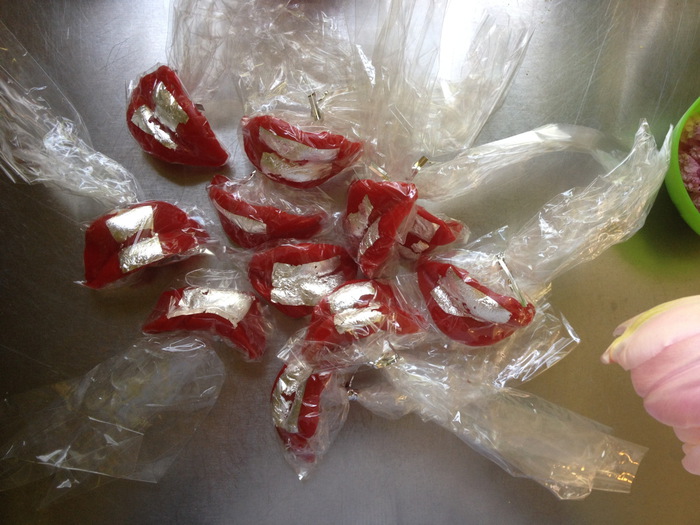
This post is for the archivists out there, and is inspired by putting away sweaters and Paul Soulellis’s Rhizome post about zip files.
In September 2010 I wrote about what I called the Gala-as-Art Movement.
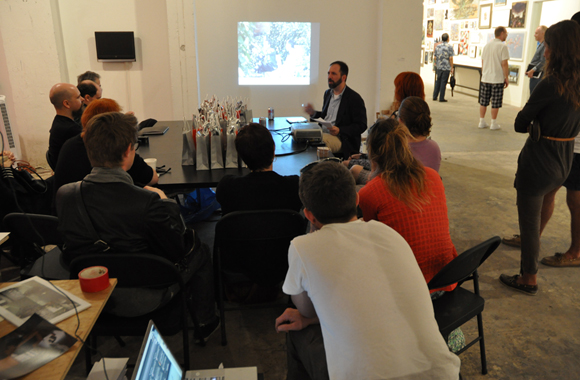
installation image of Untitled (#rank Gift Bag) via hyperallergic
In December I presented an expanded history of Relational Aesthetics For The Rich at #rank, Jen Dalton and William Powhida’s Art Basel Miami Beach follow-up to #class. Both #rank and #class were done for Ed Winkleman Gallery. #rank was actually part of Seven, the independent satellite exhibition. I later put a poorly edited audio/slideshow version of the Gala As Art on Vimeo. I expect I will edit the transcript and images into book form as well.
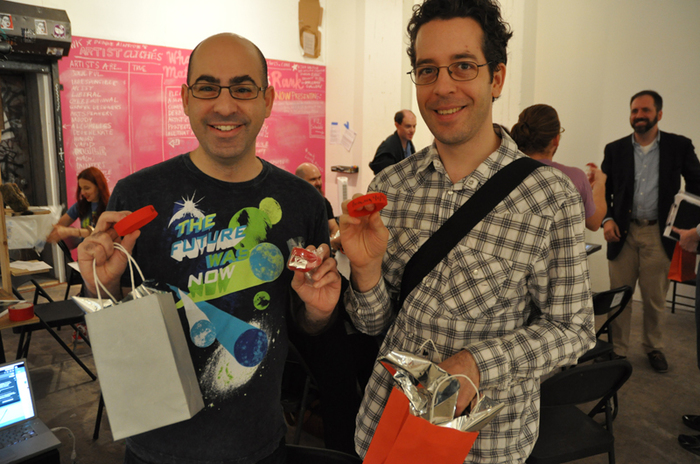
I decided at the last minute to create an edition for the #rank event, and that the most appropriate form was a gift bag. I was reminded of how, staying true to its gift bag nature, I had not explained the edition, and had not identified it as an edition per se, even though, if you looked, there were clues. Up until now, this Hyperallergic photo of Veken and Jesse Lambert was the only public documentation of this edition.
Then I was putting some sweaters away this weekend, and I found a bag of leftover parts from editions that had gone uncollected after the event. I will now describe the edition, its elements, and its development.
The impetus for an edition was the gold-leaf chocolate lips dessert edition created by Kreemart for Marina Abramovic’s The Artist Is Present after-gala. I put edible silver leaf on red wax lips, and repackaged them. I also bought edible gold leaf, which, having never bought it before, I found unexpectedly expensive. I tested with the silver and found it satisfying, but I did not return the gold.
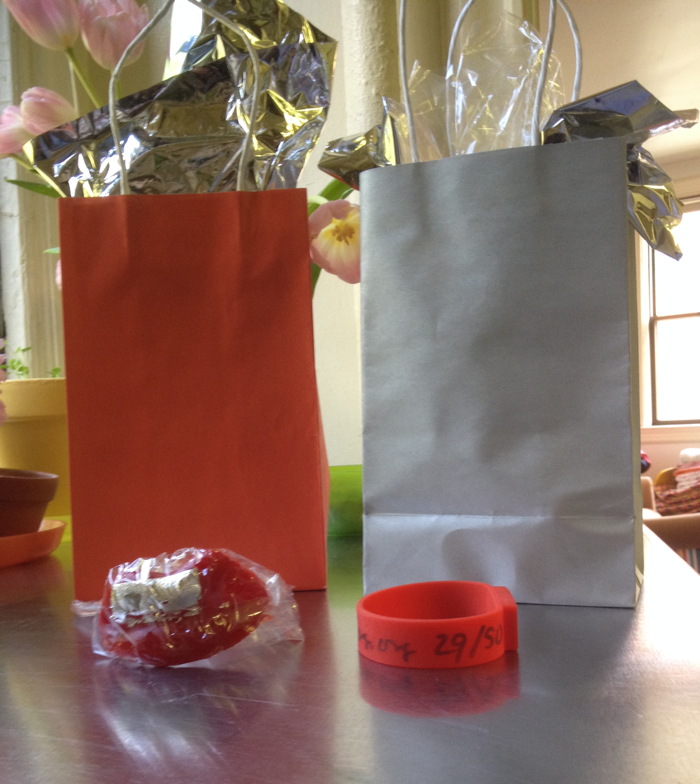
The lips alone were insufficient, however, and thus the gift bag idea was reached. The color theme came from the silvered lips, which, as the colors of a Diet Coke can, also evoked the autobiographical. I wanted to add a tchotchke, like a LIVESTRONG bracelet, but the lead time was killing me.
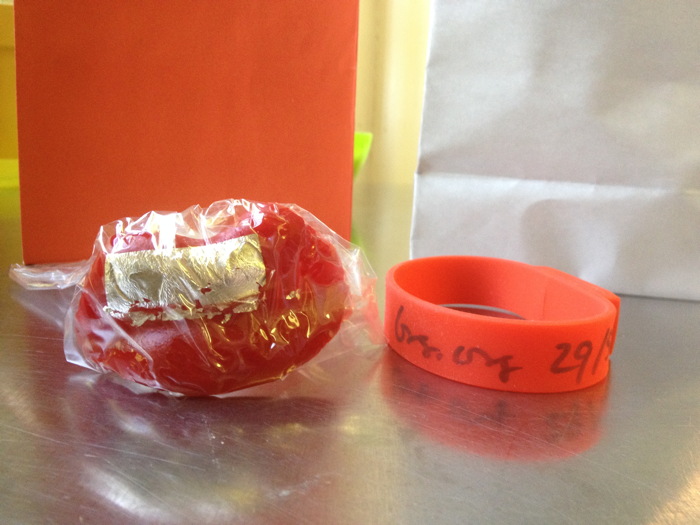
I decided to publish the supporting media for the project the way Doug Aitken had made an artist book for his MOCA Happening. I thought of burning a bunch of DVDs, but I didn’t want to get all designy. I thought of a customized USB stick, but again, I had too little lead time. These two objects merged into one, though, when I found a silicone bracelet with USB memory embedded. I signed and numbered the band, and named each drive with its edition number. I remember after the event, hearing people not realizing it was a USB stick, and thinking oh well, no one gets it, and no one will ever see it.
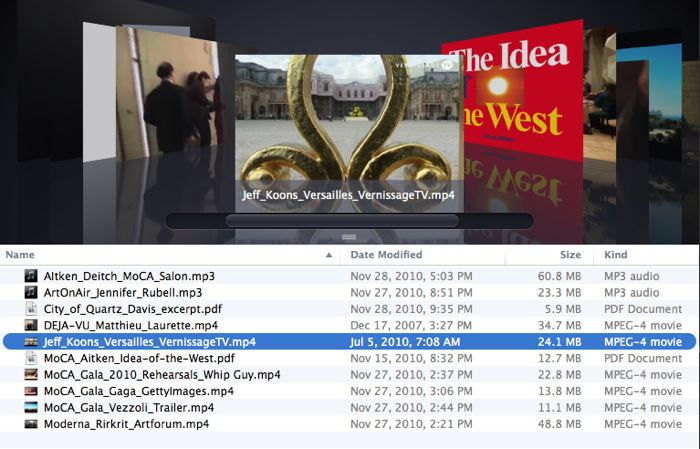
In the few minutes between finding these USB bracelets and opening one again, I imagined publishing the whole thing as an e-book, or a PDF. I’d remembered more texts and fewer videos. Which is why Soulellis’s zip file art publishing stuck in my mind. But that’s the beauty of zip-based publishing: it can take anything. And so they’re here, as Gala-as-Art_Gift_Bag.zip. The contents are as seen in the screenshot above.
The bag also contained a card, in the format of a gala invitation, in which all the artists mentioned were listed as benefit committee members. I have not found the leftover stack of these cards, which were hastily and unsatisfyingly produced on the ground at some Kinko’s in Miami Beach. But when I do, I will document it here.
The bags are similarly suboptimal, looking nothing like their pictures in the Oriental Trading Co. catalog. The silver mylar, however, is just right, and should be properly considered by future historians of the exhibition history of satelloons.
Untitled (#rank Gift Bag) is the second time I’ve introduced an artwork in the context of a presentation. Instead of site-specific, they’re situation-specific. In each case, I took Cary Leibowitz’s practice to heart, and signed something “so you won’t throw it away.” And yet even considering fluxus and James Lee Byars and the stuff I’ve got socked away in storage, I expect that few if any examples of either piece have survived in the wild. I also expect that it doesn’t matter.
So while this doesn’t reconstitute the works, and I’m not inclined to do anything with the leftovers, when it comes to ever discussing the works and their experience, I have changed my position on whether you really had to be there.
Gala-as-Art_Gift_Bag.zip [dropbox greg.org, 254mb]
Previously: An Incomplete History of The Gala-as-Art Movement [greg.org]
The Gala As Art As Slideshow [ibid.]
The Gala As Art, greg.org, at #rank 2010 [vimeo]
Why Ed Winkleman did #rank at the Seven Miami Art Fair [hyperallergic]
Redneck-Flown Confederate Flag

What’s that? #20 – Soyuz TMA-5 Flown Flag? Oh nothing, just a flag, like you’d see anywhere.
Next month RR Auction is selling a Confederate Flag that flew on the International Space Station. It is signed by Salizhan Sharipov, the Russian cosmonaut who brought at least five of the flags to the ISS in 2004-5, and by NASA’s own Leroy Chiao, who was the commander of the pair’s 6-month expedition.
The flags caused an uproar when they first started appearing on the flown souvenir market in 2006, and both Chiao and Sharipov acted like they had no idea how those flags might’ve–Confederate flags, you say? Well how’d that–who coulda–
Which seems like total crisis PR-driven bullshit, and a lot of needless racist hassle for a couple hundred bucks. But anyway, here one of the apparent five flown is.
#20 – Soyuz TMA-5 Flown Flag, est. $200, sold for $437.33 [rrauction]
How Did A Confederate Flag Get Aboard the International Space Station? [spaceref]
Untitled (YOUR NAME HERE), Study for Dasha

Satellite Communication: Untitled (YOUR NAME HERE), Study for Dasha
Previously: If I Were A Sculptor, But Then Again
On Roman Balls
I was looking up something else entirely when I came across this post at the travel blog, Rome the Second Time, an architecture professor explaining how giant balls are a “very fascist” architectural element, which were popular starting in the 1920s.
The photo above is of a fascist-era housing complex in Garbatella, for example, and there are several more great examples.
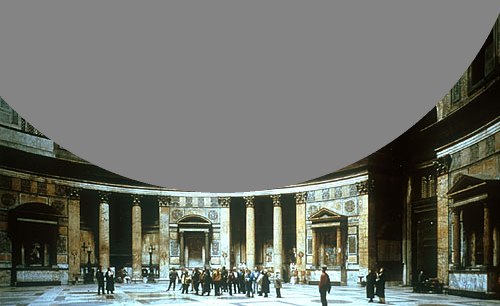
Which, on the one hand, good to know, because seven years ago, when I first mapped out the world for places that could accommodate showing a 100-foot-diameter satelloon as an art object, the Pantheon in Rome was one of only a handful of possibilities. In concept, in fact, it seems like it’d be the perfect choice. [Eventually the Grand Palais in Paris joined the list, too.] But if spheres read to Romans as fascistic artifacts, you’d need to take that into account.
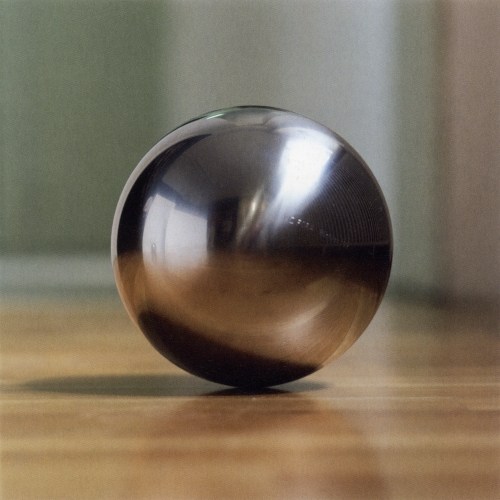
The perfection the fascists loved also made Gerhard Richter very skeptical of spheres. He complained that with spheres it’s “impossible to get any closer to perfection,” and so you stop. Except when you don’t; 16 years after he said this Richter created his own shiny steel sphere editions.
The Balls of Rome [romethesecondtime]
previously:
If I Were A Sculptor, But Then Again…
Les Sateloons du Grand Palais
Shiny Balls by Gerhard Richter
Seeing Stars: These Two Interviews On Aperture Right Now
Oh, nothing, just my Q&A with Aperture editor Brian Sholis hanging there online next to THOMAS RUFF. Brian and I went back and forth, discussing the photographs in Exhibition Space and how they relate to art historical developments like conceptual photography and Minimalism.
Meanwhile, Michael Famighetti interviewed Ruff for Aperture’s upcoming Summer issue, and the photographer talked about the beginnings of his Sterne series, the giant photos made using imagery from the European Southern Observatory’s Southern Sky Survey. Ruff’s work was one of the triggers for my own interest in the Palomar Observatory Sky Survey, which was the ESO’s Northern predecessor. Anyway, I think this is the first he’s discussed the series’ origins in English:
MF: Could you talk about the role of research in your work? Where does a project begin?
TR: If I see an image that attracts, upsets, or astonishes me–one that stays in my mind for a long time–I begin working. This is the starting point of the research: I try to find out how the image was created and in what context–historical, political, or social–the image belongs. After clarifying these questions I begin to create “my own” image, the image I have in my mind, the image that was triggered by the image I saw. Sometimes it can be done in a straightforward way, with a camera, but sometimes you need to reflect on how you can manage to make this technically. For example, when I had the idea of photographing the night sky, I realized that with my small telescope, I had no chance of getting high-quality images of stars, so I looked for an observatory with a big telescope where I could take the photographs myself. But they wouldn’t let me in. So I had to give up the idea of being the author of the photograph, and worked with large-format negatives from the observatory’s archive.
Yes, authorship.
And speaking of authorship [and much more], in his talk with Jörg Colberg for Conscientious, Ruff mentioned authorship and his new show at David Zwirner:
JC: I was going to ask you about that, the idea of landscape photography. Scientific photographs, say the Mars rover images, in principle are landscape photographs along the lines of early survey landscape photography in the American West.
TR: That’s where it continues. On top of that, it’s also about automated photography, photographs made by robots. That’s all part of it, the surrender of authorship… Ma.r.s. contains a bit more authorship than Stars where all I did was to select the area and to do the cropping.
All I did? After all this time, do we find out is Ruff a traditionalist?
Thomas Ruff: Photograms for the new age [aperture.org]
Interview with Greg Allen [aperture.org]
Previously: Thomas Ruff’s Sterne
Organizer-Artist vs Artist-Organizer

The new Frieze begins its series of artists talking about curating and being curated [sub req] with Daniel Buren’s classic 1972/1992 statement in Harald Szeeman’s Documenta 5, “Exhibitions of an Exhibition.”
I never registered it before, but Buren uses the term “organizer” for curator. Which is ironic, because at apexart several years ago, at the thin wedge of the emerging trend/abuse, they moved away from using the term “curator”–in favor of “organizer.” And the sense I’ve gotten while working on Exhibition Space is that they were seeking to get away from exactly the curator-as-artist/exhibition-as-art pretensions or associations that Buren was kvetching about in 1972.
In any case, now that I’m an organizer, and apparently the worst of Buren’s fears realized, here are some excerpts from his 1992 English translation of “Exhibitions of an Exhibition”:
Exhibitions of an exhibition
More and more, the subject of an exhibition tends not be the display of artworks, but the exhibition of the exhibition as a work of art….
The works presented are carefully chosen touches of color in the tableau that composes each section (room) as a whole.
There is even an order to these colors, these being defined and arranged according to the drawn design of the section (selection) in which they are spread out/presented.
These sections (castrations), themselves carefully chosen “touches of color” in the tableau that makes up the exhibition as a whole and in its very principle, only appear by placing themselves under the wing of the organizer, who reunifies art by rendering it equivalent everywhere in the case/screen that he prepares for it.
The organizer assumes the contradictions; it is he who safeguards them.
It is true, then, that the exhibition establishes itself as its own subject, and its own subject as a work of art. The exhibition is the “valorizing receptacle” in which art is played out and founders, because even if the artwork was formerly revealed thanks to the museum, it now serves as nothing more than a decorative gimmick for the survival of the museum as tableau, a tableau whose author is none other than the exhibition organizer.
Which, in 2003, prefaced his response to the idea, proposed by e-flux and Jens Hoffman, that “The Next Documenta Should Be Curated By an Artist.”:
Could a large-scale exhibition like Documenta be entrusted to an artist? If the tendency remarked upon here continues to hold, my response would undoubtedly be “yes.” For the artist-organizer would erase the faults inherent in the organizer-artist. For example, it would be worth betting that the announcement of an artist-organizer, whoever he or she might be, would cause an immense outcry of lamentations from the choir of the majority of all the other panic-stricken and destabilized artists.
This will be a varied and serious song. Its reasons for being will be intelligent, stupid, and revealing at the same time. They will be founded on jealousy, on the one hand, and fear of the artist-organizer’s positions, on the other. Artists, exacerbated individualists if ever they existed, would show that their corporatist spirit is not as remote as it may seem. One would notice, then, that the critiques suddenly raised by the announcement of the name of an artist-organizer had never been raised by the announcement of any organizer-artist. This a priori predictable reaction already bears within itself the fruits of extremely positive debates, for they reveal a state of fact that has been occulted for over thirty years.
‘Exhibition Space’ Installation Snaps

Installation view: panorama of 96 photographic plates from the National Geographic Socety-Palmar Observatory Sky Survey (1949-58); the other 1,700+ plates are in the cabinet.
First off, thanks to everyone at apexart for the really amazing work on the show. “Exhibition Space” looks great, and it’s installed beautifully. Thanks, too, to the folks who have stopped by to see it, whether at the opening or since, and those who have sent along kind comments. I know Massimiliano curates three shows 10x this size each day before breakfast, but it’s still a BFD for me, and after writing and thinking about the objects and photos in the show for so long online, it really is a completely different thing to see them in person.
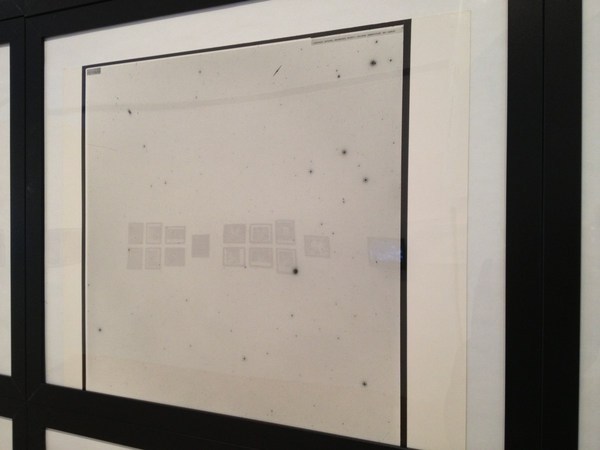
detail of a photographic plate from NGS-POSS
I’ll get some more systematic documentation shots of the show and the pieces in it soon, but in the mean time, here are some pictures I snapped last week. If you circulate them, I really hope you’ll check back and update them when I get some slicker versions.
‘Exhibition Space’ Opens Tomorrow
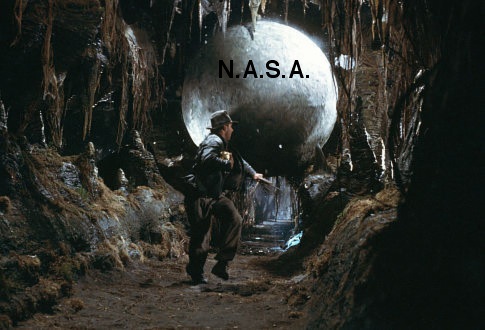
Dude. I can’t believe it’s really happening. But it is. “Exhibition Space” is opening tomorrow night at apexart in Tribeca. There’s a reception from 6-8pm, and the show will be open to the public from Thursday the 21st through May 8.
What started out as completely separate ideas, spawned, obviously, here on the blog, has turned out to have all these amazing and direct interconnections, both among the objects in the show, but also into the art of the time.
As the new banner image suggests–which I love, btw, just so awesome, like it was shot just for me–there will be some extended posting about the stuff in the show here on greg.org. So please visit often.
image above inspired by Whitney’s suggestion at AFC that I’m on some kind of Indiana Jones-like satelloon quest, which, well.
“Exhibition Space,” photographs, objects, and perception at the dawn of the Space Race, 21 Mar – 8 May 2013 at apexart [apexart.org]
Previously:
2007: The Sateloons of Project Echo, must. find. satelloons.
2008: On The Sky Atlas and the NGS-Palomar Observatory Sky Survey
Chaneling Satelloons

I’d like to announce that my satelloon show “Exhibition Space” will travel from the Grand Palais to New York, where it will open at apexart on March 20th.
I’d like to, but it—eh, you know what, it’s close enough.
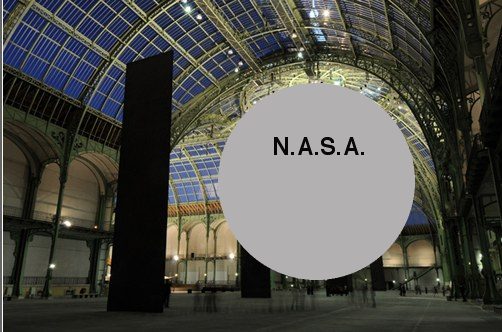
image: Chanel demands a closer look [nyt]
previously, like 2008 previously: Les Sateloons du Grand Palais
The Photographic Archive
In response to Olia Lialina’s post last week about screwy reproductions of her c.1996 lo-res digital imagery, Cass Fino-Radin writes about how Rhizome deals with archiving and documenting digital art in its native formats, platforms and resolutions: by photographing it.
This very issue of how low-resolution digital images gum up the hi-res assumptions our visual systems are built on is was one of the unexpectedly central discoveries of making Untitled (300 x 404) project. Though initially, at least, the losses and distortions of moving a thumbnail-sized jpg through the media channels were for me evidence or symbolic of the information that’s lost through ridiculous copyright restrictions, and not so concerned with archiving or perpetuation.
But that’s not important right now. Because just a few days before reading about Fino-Radin’s archival challenges, I stumbled across another data-driven use of old-school photography, on Project Echo.
I just received a rare print copy of the 1961 Bell Systems Technical Journal devoted to Project Echo, which has a dozen papers reporting Bell Labs’ findings and processes of tracking and operating an inflatable, reflective communications satellite. What’s extraordinary about the papers is what’s always fascinated me about the Echo satelloons in the first place: they were analog experiments done largely by hand, and before computers were practical tools for real-time tasks.
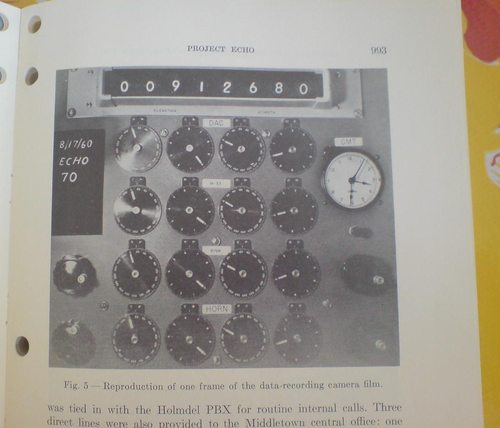
And so, for example, in order to record all the satellite tracking data and readouts at the Holmdel, NJ receiving and transmission station, they took pictures of the control panel. Here’s the description from Bell Labs project engineer Dr. William C. Jakes’ paper [available from dtic.mil as a pdf]:
In order to have a record of the positions of the various moving elements of the system during a satellite pass, each element was provided with synchro read-outs which were periodically photographed. Pictures were taken at one-second intervals of a panel carrying the two-speed azimuth and elevation position dials for the DAC, M-33 (optics), 60-foot dish, and horn antenna. A Greenwich Mean Time clock also appeared in the photographs. Position angles could be read to +/- 0.01 degrees, and time to 0.5 second. An enlargement of one frame of such a record is shown. [above]
But wait, there was more:
The 60-foot dish and horn antennas were each equipped with a bore-sight camera [!] that could be started at will whenever the satellite was visible. Pictures were taken at four frames per second, and included a reticle for indicating angular offsets to an accuracy of +/-0.01 deg. and a time-coded counter.
I have contacted archivists for Bell Labs, and unfortunately, no such operational film records have survived. In the company’s possession, anyway. But I am still looking.
Two Ships Passing In The Night
It’s not that I feel a need to apologize for breaking some imaginary overall narrative flow, but I just need to put these here for current and future reference.
First, the SS Leviathan, as seized from Germany and as outfitted in WWI-era Dazzle Camo livery:
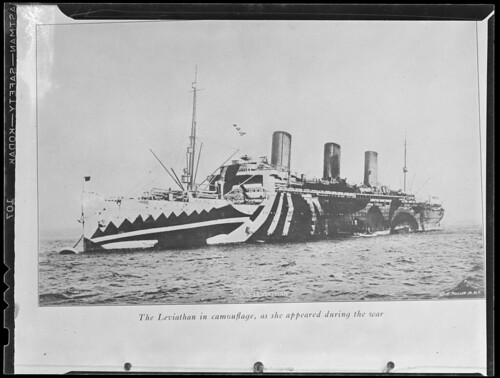
[boston public library’s flickr via proscriptus]

And then there’s the Lockheed Martin HALE-D, a next-generation military communications airship that obviously traces its design DNA back to the glorious Echo and PAGEOS satelloons of yesteryear. Unfortunately, like those ships, the HALE-D, and many of the inflatable, unmanned surveillance airships the Pentagon has burned $1 billion developing the last four years, have turned out to be an evolutionary dead end; the HALE-D crashed on its initial test flight, and the program is now on the chopping block.
